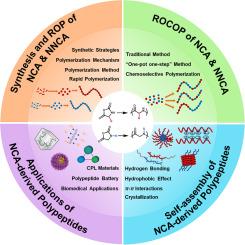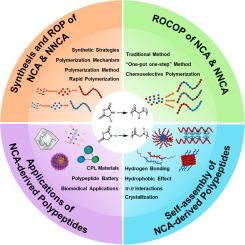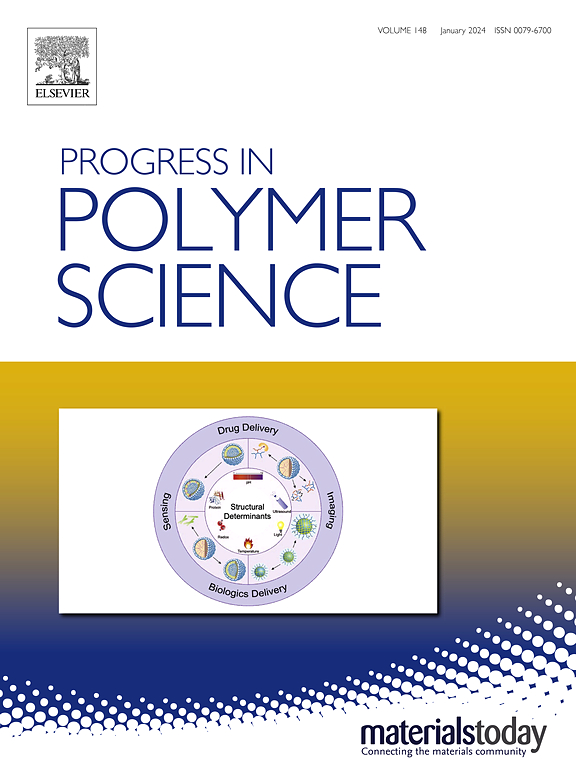n -羧基氢化物开环聚合:多肽、类肽和功能材料的有效途径
IF 26.1
1区 化学
Q1 POLYMER SCIENCE
引用次数: 0
摘要
多肽作为自然界中最引人注目的生物大分子之一,由于其具有类似蛋白质的结构,具有巨大的应用潜力。自20世纪初发现n -羧基氢化物(NCA)单体以来,这些环状衍生物克服了氨基酸缩聚的固有挑战,彻底改变了多肽合成。NCA在高分子科学和材料工程领域一直是一个活跃的研究前沿。在这篇综述中,我们批判性地总结了nca基聚合策略的最新进展。我们首先强调开环聚合方法,然后深入讨论共聚体系,重点是单体相容性。由于分子组装是连接聚合物合成与功能应用的关键桥梁,我们随后分析了nca衍生多肽的各种自组装机制,重点阐明了不同超分子结构背后的驱动力。此外,我们全面概述了这些多肽材料在生物医学和纳米技术领域的新兴功能应用。我们批判性地分析持续的挑战,同时绘制该领域的新兴研究前沿。本文不仅综述了NCA聚合的最新进展,而且为分子组装提供了机制见解,并为推进下一代功能多肽材料的应用提供了路线图。本文章由计算机程序翻译,如有差异,请以英文原文为准。


Ring-opening polymerization of N-carboxyanhydrides: An efficient approach toward peptides, peptoids, and functional materials
Polypeptides, as one of the most remarkable biomacromolecules in nature, possess immense application potential due to their protein-mimetic architectures. Since the discovery of N-carboxyanhydride (NCA) monomers in the early 20th century, these cyclic derivatives have revolutionized polypeptide synthesis by overcoming the inherent challenges in amino acid polycondensation. NCA remains an active research frontier in polymer science and materials engineering. In this review we critically summarize recent advances in NCA-based polymerization strategies. We first highlight ring-opening polymerization approaches, followed by an in-depth discussion on copolymerization systems with emphasis on monomer compatibility. As molecular assembly serves as the critical bridge connecting polymer synthesis to functional applications, we subsequently analyze various self-assembly mechanisms of NCA-derived polypeptides, with a focus on elucidating the driving forces underlying different supramolecular architectures. Furthermore, we comprehensively overview the emerging functional applications of these polypeptide materials across biomedical and nanotechnology domains. We critically analyze persistent challenges while charting emergent research frontiers in this field. This review not only consolidates the recent progress in NCA polymerization but also provides mechanistic insights into molecular assembly and a roadmap for advancing functional polypeptide materials in next-generation applications.
求助全文
通过发布文献求助,成功后即可免费获取论文全文。
去求助
来源期刊

Progress in Polymer Science
化学-高分子科学
CiteScore
48.70
自引率
1.10%
发文量
54
审稿时长
38 days
期刊介绍:
Progress in Polymer Science is a journal that publishes state-of-the-art overview articles in the field of polymer science and engineering. These articles are written by internationally recognized authorities in the discipline, making it a valuable resource for staying up-to-date with the latest developments in this rapidly growing field.
The journal serves as a link between original articles, innovations published in patents, and the most current knowledge of technology. It covers a wide range of topics within the traditional fields of polymer science, including chemistry, physics, and engineering involving polymers. Additionally, it explores interdisciplinary developing fields such as functional and specialty polymers, biomaterials, polymers in drug delivery, polymers in electronic applications, composites, conducting polymers, liquid crystalline materials, and the interphases between polymers and ceramics. The journal also highlights new fabrication techniques that are making significant contributions to the field.
The subject areas covered by Progress in Polymer Science include biomaterials, materials chemistry, organic chemistry, polymers and plastics, surfaces, coatings and films, and nanotechnology. The journal is indexed and abstracted in various databases, including Materials Science Citation Index, Chemical Abstracts, Engineering Index, Current Contents, FIZ Karlsruhe, Scopus, and INSPEC.
 求助内容:
求助内容: 应助结果提醒方式:
应助结果提醒方式:


